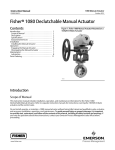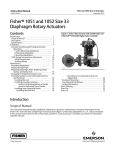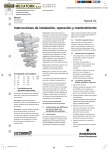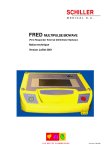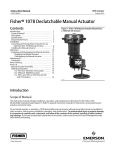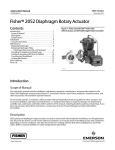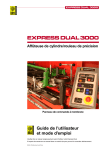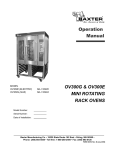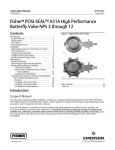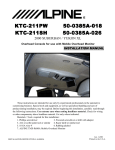Download Emerson Fisher 1079 Installation Instructions
Transcript
Instruction Manual 1079 Manual Actuator D500208X012 October 2012 Fisherr 1079 Declutchable Manual Actuator Contents Introduction . . . . . . . . . . . . . . . . . . . . . . . . . . . . . . . . . 1 Scope of Manual . . . . . . . . . . . . . . . . . . . . . . . . . . . . . 1 Description . . . . . . . . . . . . . . . . . . . . . . . . . . . . . . . . . 2 Specifications . . . . . . . . . . . . . . . . . . . . . . . . . . . . . . . 2 Educational Services . . . . . . . . . . . . . . . . . . . . . . . . . 2 Installation . . . . . . . . . . . . . . . . . . . . . . . . . . . . . . . . . . 3 Installing the Manual Actuator . . . . . . . . . . . . . . . . . 4 Operation . . . . . . . . . . . . . . . . . . . . . . . . . . . . . . . . . . . 5 Engaging and Disengaging the Manual Actuator . . 5 Engaging the Manual Actuator . . . . . . . . . . . . . 5 Disengaging the Manual Actuator . . . . . . . . . . 5 Maintenance . . . . . . . . . . . . . . . . . . . . . . . . . . . . . . . . . 6 Lubrication . . . . . . . . . . . . . . . . . . . . . . . . . . . . . . . . 10 Parts Ordering . . . . . . . . . . . . . . . . . . . . . . . . . . . . . . . 11 Parts List . . . . . . . . . . . . . . . . . . . . . . . . . . . . . . . . . . . 11 Manual Actuator Assembly . . . . . . . . . . . . . . . . . . . 11 Figure 1. Fisher 1079 Manual Actuator Mounted on a Hytork Actuator and A41 Double D Valve W6214 Introduction Scope of Manual This instruction manual includes installation, operation, and maintenance information for the Fisher 1079 declutchable manual actuator. Refer to separate instruction manuals for instructions covering the Hytork actuator and the control valve. Do not install, operate, or maintain a 1079 manual actuator without being fully trained and qualified in valve, actuator, and accessory installation, operation, and maintenance. To avoid personal injury or property damage, it is important to carefully read, understand, and follow all the contents of this manual, including all safety cautions and warnings. If you have any questions about these instructions, contact your Emerson Process Management sales office before proceeding. www.Fisher.com Instruction Manual 1079 Manual Actuator October 2012 D500208X012 Table 1. Specifications Available Configurations Direct acting; see Handwheel Rotation Manual Actuator Sizes See tables 2, 3, and 4 Power Actuator Compatibility Compatible with all sizes of Hytork actuator; see tables 2, 3, and 4 Maximum Torque Output See tables 2, 3, and 4 Wheel-Rim Force See tables 2, 3, and 4 Handwheel Rotation Clockwise handwheel rotation closes valve (produces clockwise valve shaft rotation; as viewed from the actuator end of the shaft) Standard Mounting Positions (see figure 2) J Standard mounting is with the input shaft perpendicular to the Hytork piston travel, with the handwheel opposite the actuator supply connections; J Optional mounting is with the handwheel on the same side as the Hytork actuator supply connections. Approximate Weight without Handwheel Size AAA: 7.3 kg (16 lb) Size AA: 10 kg (22 lb) Size A: 14 kg (31 lb) Size B: 16 kg (35 lb) Size C: 24 kg (52 lb) Size D: 33 kg (72 lb) Handwheel Weight 6-inch: 1.0 kg (2.25 lb) 8-inch: 2.0 kg (4.50 lb) 12-inch: 4.0 kg (8.75 lb) 24-inch: 5.4 kg (12.00 lb) 30-inch: 6.7 kg (14.75 lb) 36-inch: 7.8 kg (17.25 lb) Description The 1079 manual actuator, shown in figure 1, is a declutchable unit for manual operation of keyed or square shaft control valves and equipment that use a Hytork actuator. The 1079 manual actuator mounts directly on the Hytork actuator and can be engaged to allow manual operation of the valve when the power actuator is not in use or disengaged to allow automatic operation of the valve by the power actuator. The mechanism used allows manual actuator engagement at any point of power actuator rotation. Specifications The 1079 manual actuator specifications are given in table 1. Educational Services For information on available courses for 1079 manual actuators, as well as a variety of other products, contact: Emerson Process Management Educational Services, Registration P.O. Box 190; 301 S. 1st Ave. Marshalltown, IA 50158-2823 Phone: 800-338-8158 or Phone: 641-754-3771 FAX: 641-754-3431 e-mail: [email protected] 2 Instruction Manual 1079 Manual Actuator D500208X012 October 2012 Installation WARNING Always wear protective gloves, clothing, and eyewear when performing any installation operations. To avoid personal injury or property damage resulting from the sudden release of pressure, do not install the valve assembly where service conditions could exceed the limits given on the valve and actuator nameplates. Use pressure-relieving devices as required by accepted industry, local, state, or Federal codes, and good engineering practices. Check with your process or safety engineer for any other hazards that may be present from exposure to process media. If installing into an existing application, also refer to the WARNING at the beginning of the Maintenance section in this instruction manual. The 1079 manual actuator is normally shipped mounted on the Hytork actuator. If the manual actuator is shipped separately for installation on the Hytork actuator, or if the manual actuator was removed for maintenance, mount the manual actuator by following the instructions in this section. Field conversion of the Hytork actuator for use with the 1079 manual actuator requires fastening a mounting plate, included with the manual actuator, to the Hytork actuator. The 1079 actuator is installed between the valve and the Hytork actuator. Figure 2 shows the manual actuator standard and optional mounting positions. Typically the manual actuator is mounted with the input shaft perpendicular to the power actuator piston travel. However, the manual actuator can be mounted in any of four positions, provided there is sufficient clearance between the handwheel and the power actuator end caps. Fasten the mounting plate to the power actuator with the four mounting bolts provided with the manual actuator. Do not exceed the torque values given in table 5. Figure 2. Fisher 1079 Actuator Mounting Positions STANDARD MOUNTING POSITION SEAL RETAINER SIDE OF VALVE HYTORK ACTUATOR SUPPLY CONNECTIONS OPTIONAL MOUNTING POSITION A6186 3 1079 Manual Actuator Instruction Manual October 2012 D500208X012 Installing the Manual Actuator WARNING Refer to the WARNING at the beginning of the Maintenance section in this instruction manual. CAUTION Undertravel or overtravel of the valve disk, especially at the closed position, may result in poor valve performance and/or damage to the equipment. Make certain that the power actuator travel stops are properly set before installing and adjusting the manual actuator. Refer to the instruction manuals for the valve and the power actuator for information about setting travel stops. 1. Isolate the control valve from the line pressure, release pressure from both sides of the valve body, and drain the process media from both sides of the valve. Also shut off all pressure lines to the power actuator and release all pressure from the power actuator. Use lock-out procedures to be sure that the above measures stay in effect while you work on the equipment. 2. Make certain that the power actuator travel stops have been properly set. 3. For spring-return power actuators, allow the power actuator to remain in the position where the spring is relaxed. For double-acting power actuators, apply supply pressure as appropriate to position the valve disk in either the open or closed position. 4. Note whether the valve disk is in the open or closed position. 5. Engage the handwheel on the manual actuator. See the Engaging and Disengaging the Manual Actuator section in this manual for instructions. Perform one or the other of the following procedures. D If the valve disk is in the closed position: Rotate the handwheel clockwise until it stops. D If the valve disk is in the open position: Rotate the handwheel counterclockwise until it stops. 6. Disengage the manual actuator. 7. Slide the manual actuator shaft into the power actuator. 8. Rotate either the manual actuator or the power actuator slightly so that the mounting holes on the manual actuator align with the mounting holes in the mounting plate on the power actuator. 9. Fasten the manual actuator to the power actuator with the bolts, lockwashers, and nuts provided. 10. Install the power actuator and manual actuator assembly on the valve as described in the installation section of the power actuator instruction manual. 4 Instruction Manual 1079 Manual Actuator D500208X012 October 2012 Operation After the actuator and control valve assembly are installed, the manual actuator is ready for operation. CAUTION Applying too much torque to the actuator and valve parts could cause damage to the parts. To avoid such damage, do not exceed the maximum allowable torques listed in table 2, 3, or 4 or any other torque limitation of internal valve parts. Also, do not use wrenches or other devices on the handwheel or handwheel shaft to increase operating force. If the force required to rotate the handwheel exceeds the wheel-rim force listed in table 2, 3, or 4, refer to the maintenance procedures. Engaging and Disengaging the Manual Actuator WARNING Refer to the WARNING at the beginning of the Maintenance section in this instruction manual. Engaging the Manual Actuator 1. Shut off supply pressure to the power actuator. 2. Pull the ring on the detent mechanism to unlock the lever. Move the lever into the engaged position until it is against the stop pin and locked in position by the detent mechanism. 3. If applicable, open the power actuator bypass valve. Disengaging the Manual Actuator CAUTION Disengaging the manual actuator when forces such as spring compression, cylinder pressure, and dynamic torque are present may cause sudden, extreme movement of all control valve components. This can result in damage to equipment and violent disturbance of the process. Before disengaging the manual actuator, approximate system balance should be achieved. Take appropriate steps to ensure that the return to automatic operation will not result in a extreme repositioning of control valve components. 1. Before disengaging the manual actuator, approximate system balance should be achieved. The system is in balance when the actual valve disk position is approximately the same as the position requested by the automatic control system. Under balanced system conditions, the manual actuator disengaging lever moves freely without use of excessive force. If after releasing the detent mechanism, the lever does not move freely toward the disengaged position, some system force is causing an imbalance. A forced return to automatic operation under these conditions can cause serious damage to the equipment and violent disturbance of the process. 5 1079 Manual Actuator October 2012 Instruction Manual D500208X012 2. If possible, determine whether the automatic control system is tending to open or close the valve disk, and rotate the handwheel in the appropriate direction until friction in the manual operator is reduced and the lever can be easily moved by hand. As an alternate approach, local manipulation of the supply pressure to the power actuator may bring the set point of the automatic system closer to the actual valve disk position. 3. If a smooth transition from manual to automatic operation cannot be ensured, isolate the valve from the process. Position the manual actuator so that it matches the position of the disk when no supply pressure is applied to the power actuator. 4. Pull the ring on the detent mechanism to unlock the lever. Push the lever into the disengaged position until it is against the stop pin and locked in position by the detent mechanism. 5. Close the bypass valve and return supply pressure to the power actuator. Maintenance WARNING Avoid personal injury from sudden release of process pressure or bursting of parts. Before performing any maintenance operations: D Do not remove the actuator from the valve while the valve is still pressurized. D Always wear protective gloves, clothing, and eyewear when performing any maintenance operations to avoid personal injury. D Disconnect any operating lines providing air pressure, electric power, or a control signal to the power actuator. Be sure the actuator cannot suddenly open or close the valve. D Use bypass valves or completely shut off the process to isolate the valve from process pressure. Relieve process pressure from both sides of the valve. Drain the process media from both sides of the valve. D Vent the power actuator loading pressure and relieve any actuator spring precompression. D Use lock-out procedures to be sure that the above measures stay in effect while you work on the equipment. D The valve packing box may contain process fluids that are pressurized, even when the valve has been removed from the pipeline. Process fluids may spray out under pressure when removing the packing hardware or packing rings, or when loosening the packing box pipe plug. D Check with your process or safety engineer for any additional measures that must be taken to protect against process media. If the force required to rotate the handwheel exceeds the wheel-rim force listed in table 2, 3, or 4, check for the following conditions: D Insufficient lubrication D Seized actuator parts D Excessive pressure drop across the valve, or D Obstruction to the valve disk rotation. If the manual actuator does not seem to control the process fluid, the worm or drive sleeve gear teeth may be broken, the handwheel pin may be sheared, or the internal power actuator or valve parts may be broken. Purchase a replacement manual actuator if necessary. Refer to the power actuator and valve instruction manuals if power actuator or valve maintenance is needed. 6 Instruction Manual 1079 Manual Actuator D500208X012 October 2012 Table 2. Actuator Size Selection and Specifications for Keyed Shaft Valves (Model A31A) ACTUATOR SIZE AAA AA A B C D HYTORK ACTUATOR SIZE 70 thru 280 70 thru 280 680A 1125 1370 2585 & 4580 GEAR RATIO 24:1 mm Inches mm Inches MAXIMUM ALLOWABLE TORQUE(2) NSm lbfSin N lbf 203 8 14.3 0.5625 129 1145 214 48 17.5 23.8 14.3 17.5 23.8 28.6 30.2 31.8 41.3 0.6875 0.9375 0.5625 0.6875 0.9375 1.125 1.1875 1.25(4) 1.625 245 271 129 245 542 542 542 542 542 2165 2400(3) 1145 2165 4800(3) 4800(3) 4800(3) 4800(3) 4800(3) 267 298 151 298 418 418 418 418 418 60 67 34 64 94 94 94 94 94 24 14.3 17.5 23.8 28.6 30.2 31.8 41.3 0.5625 0.6875 0.9375 1.125 1.1875 1.25(4)(5) 1.625 129 245 671 834 926 926 926 1145 2165 5941 7383 8200(3) 8200(3) 8200(3) 44 80 222 276 302 302 302 10 18 50 62 68 68 68 24 23.8 28.6 31.8 30.2 31.8 38.1 41.3 44.5 47.6 0.9375 1.125 1.25(4) 1.1875 1.25(5) 1.5 1.625 1.75 1.875 671 834 927 1171 1233 1582 1582 1582 1582 5941 7383 8205 10,360 10,911 14,000(3) 14,000(3) 14,000(3) 14,000(3) 182 227 254 320 338 431 431 431 431 41 51 57 72 76 97 97 97 97 23.8 28.6 31.8 30.2 31.8 38.1 41.3 44.5 47.6 31.8 30.2 31.8 38.1 0.9375 1.125 1.25(4) 1.1875 1.25(5) 1.5 1.625 1.75 1.875 1.25(4) 1.1875 1.25(5) 1.5 671 834 927 1171 1233 2203 2530 2568 2712 927 1171 1233 2203 5941 7383 8205 10,360 10,911 19,494 22,396 22,728 24,000(3) 8205 10,360 10,911 19,494 138 169 187 236 249 445 409 418 440 160 200 209 378 31 38 42 53 56 100 92 94 99 36 45 47 85 HANDWHEEL DIAMETER 305 12 203 8 305 12 24:1 40:1 40:1 610 610 WHEEL-RIM FORCE FOR MAXIMUM TORQUE 610 24 762 30 610 24 762 30 41.3 44.5 1.625 1.75 2530 2568 22,396 22,728 347 351 78 79 914 36 47.6 57.2 1.875 2.25 4067 4067 36,000(3) 36,000(3) 463 463 104 104 54:1 64:1 VALVE SHAFT DIAMETER(1) 1. Shaft diameter at the keyway. 2. Unless otherwise noted, torque is limited by S17400 stainless steel (17-4PH H1025) shaft material at 38_C (100_F). For other shaft materials, consult your Emerson Process Management sales office. 3. Maximum manual actuator output. 4. NPS 12 CL150 A31A and NPS 8 CL300 A31A. 7 Instruction Manual 1079 Manual Actuator October 2012 D500208X012 Table 3. Actuator Size Selection and Specifications for Valves (Fisher A41) ACTUATOR SIZE AAA AA HYTORK ACTUATOR SIZE 70 thru 280 70 thru 280 GEAR RATIO 24:1 HANDWHEEL DIAMETER mm Inches 152 6 8 305 12 15.9 0.625 138 1225 152 34 12.7 15.9 19.1 0.500 0.625 0.750 58 138 240 515 1225 2120 127 305 392 29 69 88 19.1 25.4 31.8 31.8 38.1 0.750 1.000 1.250 1.250 1.500 240 468 542 542 542 2120 4140 4800(3) 4800(3) 4800(3) 280 546 629 418 418 63 123 141 94 94 19.1 25.4 31.8 38.1 0.750 1.000 1.250 1.500 240 468 926 926 2120 4140 8200(3) 8200(3) 78 153 303 303 18 34 68 68 31.8 38.1 44.5 31.8 38.1 44.5 1.250 1.500 1.750 1.250 1.500 1.750 1110 1356 1582 1110 1356 2658 9820 12000 14,000(3) 9820 12000 23524 303 371 431 227 278 433 68 83 97 51 63 97 31.8 38.1 44.5 1.250 1.500 1.750 1110 1356 2658 9820 12000 23524 190 231 365 43 52 82 152 6 203 8 203 8 305 12 24:1 40:1 610 24 B 1125 40:1 610 24 C 1370 54:1 610 24 762 30 610 24 762 30 64:1 WHEEL-RIM FORCE FOR MAXIMUM TORQUE N lbf 203 680A 2585 & 4580 MAXIMUM ALLOWABLE TORQUE(2) NSm lbfSin 12.7 15.9 15.9 A D VALVE SHAFT DIAMETER(1) mm Inches 0.500 0.625 0.625 58 138 138 515 1225 1225 127 305 229 29 69 51 1. Shaft diameter at packing box. 2. Unless otherwise noted, torque is limited by S17400 (17-4 PH H1025) stainless steel shaft. For other shaft materials, contact your Emerson Process Management sales office. 3. Maximum manual actuator output. For AAA, C, and D, the maximum output is 2400, 24000, and 36000 in-lb, respectively. 8 Instruction Manual 1079 Manual Actuator D500208X012 October 2012 Table 4. Actuator Size Selection and Specifications for Square Shaft Valves (Fisher A11) ACTUATOR SIZE AAA HYTORK ACTUATOR SIZE GEAR RATIO 70 thru 280 24:1 HANDWHEEL DIAMETER mm Inches 8 10.3 0.40625 89 790 147 33 12 15.9 0.625 271 2400(3) 298 67 203 8 10.3 0.40625 89 790 102 23 305 12 15.9 22.2 0.625 0.875 318 542 2813 4800(3) 245 418 55 94 15.9 22.2 25.4 15.9 22.2 25.4 34.9 34.9 0.625 0.875 1 0.625 0.875 1 1.375 1.375 318 782 926 318 782 1351 1582 1582 2813 6922 8200(3) 2813 6922 11,956 14,000(3) 14,000(3) 102 254 302 85 214 369 431 431 23 57 68 19 48 83 97 97 15.9 22.2 25.4 34.9 34.9 15.9 22.2 25.4 34.9 34.9 0.625 0.875 1 1.375 1.375 0.625 0.875 1 1.375 1.375 318 782 1351 2712 2712 318 782 1351 3520 3520 2813 6922 11,956 24,000(3) 24,000(3) 2813 6922 11,956 31,157 31,157 67 160 276 440 440 53 133 231 400 400 15 36 62 99 99 12 30 52 90 90 24:1 A 680A 40:1 610 24 B 1125 40:1 610 24 610 24 762 30 610 24 914 36 D 2585 & 4580 WHEEL-RIM FORCE FOR MAXIMUM TORQUE N lbf 305 70 thru 280 1370 MAXIMUM ALLOWABLE TORQUE(2) NSm lbfSin 203 AA C VALVE SHAFT DIAMETER(1) mm Inches 54:1 64:1 1. Shaft diameter at square connection. 2. Unless otherwise noted, torque is limited by S17400 stainless steel (17-4 PH H1025) shaft material at 38_C (100_F). For other shaft materials, consult your Emerson Process Management sales office. 3. Maximum manual actuator output. Table 5. Fisher 1079 Manual Actuator Mounting Plate to Hytork Actuator Bolt Torque HYTORK ACTUATOR MODEL NUMBER(1) ACTUATOR MOUNTING HOLE SIZE 45 BOLT TORQUE NSm LbfSft 0.25-20 UNC 5 4 70 130 185 280 0.625-18 UNC 11 8 425A 680A 0.375-16 UNC 20 15 1125 1370 0.5-13 UNC 42 31 2585 4580 0.75-10 UNC 100 74 1. Applies to both double-acting and spring-return models. 9 1079 Manual Actuator Instruction Manual October 2012 D500208X012 Lubrication The interior parts of the 1079 manual actuator should be lubricated on a regular schedule with a quality gear lubricant. The interior parts should also be lubricated whenever difficulty in handwheel rotation indicates a need for lubrication. 1. Isolate the control valve from the line pressure, release pressure from both sides of the valve body, and drain the process media from both sides of the valve. If using a power actuator, also shut off all pressure lines to the power actuator, release all pressure from the actuator. Use lock-out procedures to be sure that the above measures stay in effect while you work on the equipment. 2. Remove the bolts that secure the power actuator to the manual actuator, and remove the power actuator. 3. Remove the four cap screws that secure the gearbox cover plate and remove the gearbox cover plate. 4. Coat the worm, the drive sleeve gear teeth, and the bearing surfaces of the gearbox housing and worm with a quality gear lubricant. 5. Install the cover plate and four cap screws. 6. Install the power actuator on the manual actuator. Figure 3. Fisher 1079 Declutchable Manual Actuator 24B0392-A 10 Instruction Manual 1079 Manual Actuator D500208X012 October 2012 Parts Ordering When corresponding with your Emerson Process Management sales office, indicate the size of the Hytork actuator. If the manual actuator was shipped separately (not attached to a Hytork actuator), give the serial number of the unit, which is shown on a tag attached to the manual actuator. WARNING Use only genuine Fisher replacement parts. Components that are not supplied by Emerson Process Management should not, under any circumstances, be used in any Fisher valve, because they may void your warranty, might adversely affect the performance of the valve, and could cause personal injury and property damage. Parts List Note Part numbers are shown for recommended spares only. For part numbers not shown, contact your Emerson Process Management sales office. Manual Actuator Assembly (figure 3) Key Description 1 2 Gearbox, cast iron Handwheel Assembly (includes handwheel and pin) 11 1079 Manual Actuator October 2012 Instruction Manual D500208X012 Neither Emerson, Emerson Process Management, nor any of their affiliated entities assumes responsibility for the selection, use or maintenance of any product. Responsibility for proper selection, use, and maintenance of any product remains solely with the purchaser and end user. Fisher is a mark owned by one of the companies in the Emerson Process Management business unit of Emerson Electric Co. Emerson Process Management, Emerson, and the Emerson logo are trademarks and service marks of Emerson Electric Co. All other marks are the property of their respective owners. The contents of this publication are presented for informational purposes only, and while every effort has been made to ensure their accuracy, they are not to be construed as warranties or guarantees, express or implied, regarding the products or services described herein or their use or applicability. All sales are governed by our terms and conditions, which are available upon request. We reserve the right to modify or improve the designs or specifications of such products at any time without notice. Emerson Process Management Marshalltown, Iowa 50158 USA Sorocaba, 18087 Brazil Chatham, Kent ME4 4QZ UK Dubai, United Arab Emirates Singapore 128461 Singapore www.Fisher.com 12 E 1993, 2012 Fisher Controls International LLC. All rights reserved.












